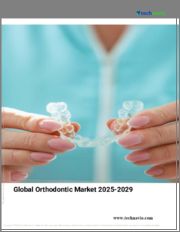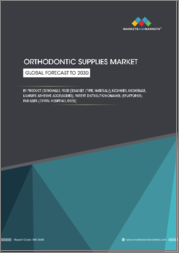
|
시장보고서
상품코드
1604574
디지털 교정 치과 시장 : 예측(2025-2030년)Digital Orthodontics Market - Forecasts from 2025 to 2030 |
||||||
디지털 교정 치과 시장은 CAGR 10.04%로 성장하며, 2025년 42억 3,221만 달러에서 2030년에는 68억 2,787만 달러의 시장 규모에 달할 것으로 예측됩니다.
디지털 교정은 전통적인 치아 교정을 디지털 방식으로 활용하는 것입니다. 이 접근 방식은 교정에서 새로운 기술을 사용하여 성인과 어린이의 심미적 인 치열 교정을보다 빠르고 정확한 방식으로 촉진하는 것을 수반합니다. 또한 교정 의사가 치료를 디지털화하여 치료 계획을 세우고 실행하는 데 도움이 됩니다. 최근에는 이러한 디지털 치과 치료가 개선되어 치과 의사가 더 짧은 시간 내에 환자를 치료할 수 있게 되었습니다. 디지털 교정 치료는 치과 의사가 구강내 디지털 장비를 통해 교정 의사가 투명교정, 와이어 및 리테이너의 둘레를 병원 내에서 측정할 수 있게 해주며, CAD/CAM 방법론과 기술은 환자를 위한 개별 와이어와 플라스틱 트레이를 만드는 데 사용되므로 점차적으로 교정 치료 진료에 점차적으로 침투하고 있습니다.
또한 디지털 툴의 채택과 사용 확대라는 새로운 동향은 디지털 교정 산업의 성장을 가속할 가능성이 높습니다. 또한 디지털 교정 솔루션 기업의 성장은 이미 존재하는 시장의 매력에 박차를 가하고 있습니다. 경쟁 증가와 새로운 시장 기회는 디지털 교정 시장의 성장을 가속할 것으로 예상됩니다. 또한 디지털 교정의 빠른 배송 시간, 비용 및 편의성은 수요를 증가시킬 것으로 예상됩니다.
디지털 교정 시장 성장 촉진요인
- AI와 ML 활용 증가로 디지털 교정 치과 시장 성장에 기여
인공지능(AI)과 머신러닝(ML)을 통합함으로써 의료진은 치료 계획 과정과 치료 결과를 개선할 수 있게 되었습니다. 또한 인공지능과 머신러닝의 활용을 포함하여 진단과 치료에 디지털 기기를 적용하는 경향이 시장에서 증가하고 있으며, AI는 지능의 진화와 그에 상응하는 기술의 개발로 인해 치열 교정 치료 시술에서 빠르게 발전하고 있습니다. 이는 스캔, 엑스레이 및 기타 관련 데이터를 통해 AI와 ML 툴을 통해 환자의 치열에 대한 정확한 3D 모델을 생성하여 치료 성공 확률을 획기적으로 높일 수 있습니다.
또한 보다 효율적이고 정확한 모델 생성 관행에 대한 수요가 증가함에 따라 치과 교정 분야에서 AI 및 ML 기술의 광범위한 채택이 촉진되고 있습니다. 또한 디지털 기술 및 3D 프린팅을 통한 맞춤형 보이지 않는 교정장비에 대한 지출이 전 세계에서 증가하고 있습니다.
디지털 교정 치과 시장의 지역적 전망
- 북미는 예측 기간 중 비약적인 성장세를 보일 것입니다.
예측 기간 중 북미가 가장 큰 시장 점유율을 차지할 것으로 예상됩니다. 이 지역에서는 구강 스캐너 및 3D 프린팅과 같은 첨단 기술 솔루션의 채택이 증가하고 있으며, 이는 디지털 교정 치과 시장의 성장을 가속할 것으로 예상됩니다. 또한 이 지역의 투자 증가와 여러 신규 시장 진출기업 및 신생 기업의 진입은 평가 기간 중 시장을 더욱 촉진할 것으로 예상됩니다. 또한 아시아태평양은 인도, 중국 등 개발도상국에서 디지털 교정 솔루션에 대한 수요가 증가함에 따라 급성장할 것으로 예상됩니다.
이 보고서를 구매해야 하는 이유
- 인사이트 분석 : 고객 부문, 정부 정책 및 사회경제적 요인, 소비자 선호도, 산업별, 기타 하위 부문에 중점을 두고 주요 지역뿐만 아니라 신흥 지역까지 포괄하는 상세한 시장 인사이트를 얻을 수 있습니다.
- 경쟁 환경: 세계 주요 기업이 채택하고 있는 전략적 전략을 이해하고, 적절한 전략을 통한 시장 침투 가능성을 파악할 수 있습니다.
- 시장 성장 촉진요인과 미래 동향 : 역동적인 요인과 매우 중요한 시장 동향, 그리고 이들이 향후 시장 발전을 어떻게 형성할 것인지에 대해 알아봅니다.
- 행동 가능한 제안: 역동적인 환경 속에서 새로운 비즈니스 스트림과 매출을 발굴하기 위한 전략적 의사결정에 인사이트을 활용합니다.
- 다양한 사용자에 대응: 스타트업, 연구기관, 컨설턴트, 중소기업, 대기업에 유익하고 비용 효율적임.
어떤 용도로 사용되는가?
산업 및 시장 검토, 사업 기회 평가, 제품 수요 예측, 시장 진출 전략, 지역적 확장, 설비 투자 결정, 규제 프레임워크 및 영향, 신제품 개발, 경쟁의 영향
분석 범위
- 과거 데이터 및 예측(2022-2030년)
- 성장 기회, 과제, 공급망 전망, 규제 프레임워크, 고객 행동 및 동향 분석
- 경쟁사 포지셔닝, 전략 및 시장 점유율 분석
- 매출 성장률 및 예측 분석 : 부문별, 지역별(국가별)
- 기업 프로파일링(전략, 제품, 재무정보, 주요 동향 등)
목차
제1장 서론
- 시장 개요
- 시장 정의
- 분석 범위
- 시장 세분화
- 통화
- 전제조건
- 기준년과 예측년 타임라인
- 이해관계자에 대한 주요 이점
제2장 분석 방법
- 분석 디자인
- 분석 프로세스
제3장 개요
- 주요 조사 결과
- CXO의 시점
제4장 시장 역학
- 시장 성장 촉진요인
- 시장 성장 억제요인
- Porter's Five Forces 분석
- 업계의 밸류체인 분석
- 애널리스트의 견해
제5장 디지털 교정 치과 시장 : 제품별
- 서론
- 구강내 스캐너
- 디지털 사진
- 3D 프린터
- 컴퓨터 지원 설계(CAD)/컴퓨터 지원 제조(CAM)
제6장 디지털 교정 치과 시장 : 최종사용자별
- 서론
- 병원
- 클리닉
- 연구기관
- 기타
제7장 디지털 교정 치과 시장 : 지역별
- 서론
- 북미
- 제품별
- 최종사용자별
- 국가별
- 남미
- 제품별
- 최종사용자별
- 국가별
- 유럽
- 제품별
- 최종사용자별
- 국가별
- 중동 및 아프리카
- 제품별
- 최종사용자별
- 국가별
- 아시아태평양
- 제품별
- 최종사용자별
- 국가별
제8장 경쟁 환경과 분석
- 주요 기업과 전략 분석
- 시장 점유율 분석
- 기업인수합병(M&A), 합의, 사업 협력
- 경쟁 대시보드
제9장 기업 개요
- 3M
- Dentsply Sirona
- Stratasys Ltd.
- 3Shape
- Altem Technologies(P) Ltd
- Align Technology, Inc
- Carestream Health
- Planmeca Oy
- Angelalign Technology
- Dentaurum
- Ormco
- Deltaface
- CADdent
- Boss Orthodontics
- FN Orthodontics
The digital orthodontics market is expected to grow at a CAGR of 10.04%, reaching a market size of US$6,827.87 million in 2030 from US$4,232.21 million in 2025.
Digital Orthodontics is leveraging traditional orthodontics in digital ways. The approach entails the facilitation of aesthetic braces for adults and children in a much quicker and more accurate way through the use of new technologies in orthodontics. It also helps orthodontists in digitalizing treatment and formulating and executing the treatment plan. In recent times, these digital dental treatments have shown improvement and helped dentists deal with patients in a much shorter timeframe. Digital orthodontics allows orthodontists to take in-house measurements around clear aligners, wires, and retainers via intra-oral digital appliances. The CAD/CAM methodologies and technologies have gradually found their way to orthodontic practices due to the use of the technologies in making individualized wires and plastic trays for patients.
Moreover, emerging trends of adoption and increasing application of digital tools are likely to boost the growth in the digital orthodontics industry. In addition, the growth of available digital orthodontic solutions companies is adding to the attractiveness of the already existing market. Increasing competition and emerging market opportunities are expected to boost the digital orthodontics market growth. Besides, shorter turn-around time, cost, and convenience of digital orthodontics are forecasted to increase demand.
Digital orthodontics market drivers
- Rising use of AI and ML is contributing to the digital orthodontics market growth
Integrating artificial intelligence (AI) and machine learning (ML) has enabled medical practitioners to improve treatment planning processes and outcomes. There is also a growing trend in the markets towards the application of digital devices in diagnosis and treatment, including the use of artificial intelligence and machine learning. AI is progressing rapidly in orthodontic treatment procedures due to the evolution of intelligence and the development of corresponding technologies. This leads to the creation of accurate 3-D models of a patient's dentition with the help of AI and ML tools through scans, X-rays, and other relevant data, dramatically increasing the probability of successful treatment.
Moreover, the increase in demand for model-generation practices that are more efficient and accurate is facilitating the wide-scale adoption of AI and ML technologies in orthodontia. In addition, there has been a global increase in expenditure on digital technologies and 3D-printed tailor-made invisible aligner braces.
Digital orthodontics market geographical outlook
- North America is witnessing exponential growth during the forecast period
During the forecast period, the North American region is expected to hold a significant market share. The rising adoption of advanced technological solutions in the region, like oral scanners, 3D printing, etc., is projected to fuel the digital orthodontics market growth. Moreover, the rising investments in the region and the entry of several new market players and start-ups are predicted to further propel the market during the assessed period. Furthermore, Asia Pacific is also projected to grow rapidly due to the increasing need for digital orthodontics solutions in developing nations such as India and China.
Reasons for buying this report:-
- Insightful Analysis: Gain detailed market insights covering major as well as emerging geographical regions, focusing on customer segments, government policies and socio-economic factors, consumer preferences, industry verticals, other sub- segments.
- Competitive Landscape: Understand the strategic maneuvers employed by key players globally to understand possible market penetration with the correct strategy.
- Market Drivers & Future Trends: Explore the dynamic factors and pivotal market trends and how they will shape up future market developments.
- Actionable Recommendations: Utilize the insights to exercise strategic decision to uncover new business streams and revenues in a dynamic environment.
- Caters to a Wide Audience: Beneficial and cost-effective for startups, research institutions, consultants, SMEs, and large enterprises.
What do businesses use our reports for?
Industry and Market Insights, Opportunity Assessment, Product Demand Forecasting, Market Entry Strategy, Geographical Expansion, Capital Investment Decisions, Regulatory Framework & Implications, New Product Development, Competitive Intelligence
Report Coverage:
- Historical data & forecasts from 2022 to 2030
- Growth Opportunities, Challenges, Supply Chain Outlook, Regulatory Framework, Customer Behaviour, and Trend Analysis
- Competitive Positioning, Strategies, and Market Share Analysis
- Revenue Growth and Forecast Assessment of segments and regions including countries
- Company Profiling (Strategies, Products, Financial Information, and Key Developments among others)
The Digital orthodontics market is segmented and analyzed as follows:
By Product
- Intraoral Scanners
- Digital Photography
- 3D Printers
- Computer-Aided Design/ Computer-Aided Manufacturing
By End-Users
- Hospitals
- Clinics
- Research Institutes
- Others
By Geography
- North America
- USA
- Canada
- Mexico
- South America
- Brazil
- Argentina
- Others
- Europe
- Germany
- France
- UK
- Spain
- Others
- Middle East and Africa
- Saudi Arabia
- UAE
- Israel
- Others
- Asia Pacific
- China
- Japan
- India
- South Korea
- Indonesia
- Taiwan
- Others
TABLE OF CONTENTS
1. INTRODUCTION
- 1.1. Market Overview
- 1.2. Market Definition
- 1.3. Scope of the Study
- 1.4. Market Segmentation
- 1.5. Currency
- 1.6. Assumptions
- 1.7. Base and Forecast Years Timeline
- 1.8. Key Benefits to the Stakeholder
2. RESEARCH METHODOLOGY
- 2.1. Research Design
- 2.2. Research Processes
3. EXECUTIVE SUMMARY
- 3.1. Key Findings
- 3.2. CXO Perspective
4. MARKET DYNAMICS
- 4.1. Market Drivers
- 4.2. Market Restraints
- 4.3. Porter's Five Forces Analysis
- 4.3.1. Bargaining Power of Suppliers
- 4.3.2. Bargaining Power of Buyers
- 4.3.3. Threat of New Entrants
- 4.3.4. Threat of Substitutes
- 4.3.5. Competitive Rivalry in the Industry
- 4.4. Industry Value Chain Analysis
- 4.5. Analyst View
5. DIGITAL ORTHODONTICS MARKET BY PRODUCT
- 5.1. Introduction
- 5.2. Intraoral Scanners
- 5.3. Digital Photography
- 5.4. 3D Printers
- 5.5. Computer-Aided Design/ Computer-Aided Manufacturing
6. DIGITAL ORTHODONTICS MARKET BY END-USERS
- 6.1. Introduction
- 6.2. Hospitals
- 6.3. Clinics
- 6.4. Research Institutes
- 6.5. Others
7. DIGITAL ORTHODONTICS MARKET BY GEOGRAPHY
- 7.1. Introduction
- 7.2. North America
- 7.2.1. By Product
- 7.2.2. By End-users
- 7.2.3. By Country
- 7.2.3.1. USA
- 7.2.3.2. Canada
- 7.2.3.3. Mexico
- 7.3. South America
- 7.3.1. By Product
- 7.3.2. By End-users
- 7.3.3. By Country
- 7.3.3.1. Brazil
- 7.3.3.2. Argentina
- 7.3.3.3. Others
- 7.4. Europe
- 7.4.1. By Product
- 7.4.2. By End-users
- 7.4.3. By Country
- 7.4.3.1. Germany
- 7.4.3.2. France
- 7.4.3.3. UK
- 7.4.3.4. Spain
- 7.4.3.5. Others
- 7.5. Middle East and Africa
- 7.5.1. By Product
- 7.5.2. By End-users
- 7.5.3. By Country
- 7.5.3.1. Saudi Arabia
- 7.5.3.2. UAE
- 7.5.3.3. Israel
- 7.5.3.4. Others
- 7.6. Asia Pacific
- 7.6.1. By Product
- 7.6.2. By End-users
- 7.6.3. By Country
- 7.6.3.1. China
- 7.6.3.2. Japan
- 7.6.3.3. India
- 7.6.3.4. South Korea
- 7.6.3.5. Indonesia
- 7.6.3.6. Taiwan
- 7.6.3.7. Others
8. COMPETITIVE ENVIRONMENT AND ANALYSIS
- 8.1. Major Players and Strategy Analysis
- 8.2. Market Share Analysis
- 8.3. Mergers, Acquisitions, Agreements, and Collaborations
- 8.4. Competitive Dashboard
9. COMPANY PROFILES
- 9.1. 3M
- 9.2. Dentsply Sirona
- 9.3. Stratasys Ltd.
- 9.4. 3Shape
- 9.5. Altem Technologies (P) Ltd
- 9.6. Align Technology, Inc
- 9.7. Carestream Health
- 9.8. Planmeca Oy
- 9.9. Angelalign Technology
- 9.10. Dentaurum
- 9.11. Ormco
- 9.12. Deltaface
- 9.13. CADdent
- 9.14. Boss Orthodontics
- 9.15. FN Orthodontics



















